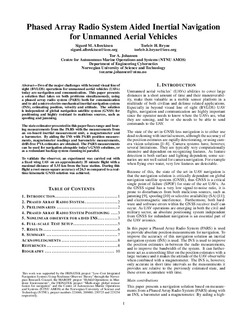| dc.contributor.author | Albrektsen, Sigurd Mørkved | |
| dc.contributor.author | Bryne, Torleiv Håland | |
| dc.contributor.author | Johansen, Tor Arne | |
| dc.date.accessioned | 2019-01-07T10:01:16Z | |
| dc.date.available | 2019-01-07T10:01:16Z | |
| dc.date.created | 2018-11-06T09:09:46Z | |
| dc.date.issued | 2018 | |
| dc.identifier.citation | IEEE Aerospace Conference. Proceedings. 2018, 2018-March 1-11. | nb_NO |
| dc.identifier.issn | 1095-323X | |
| dc.identifier.uri | http://hdl.handle.net/11250/2579418 | |
| dc.description.abstract | Two of the major challenges with beyond visual line of sight (BVLOS) operations for unmanned aerial vehicles (UAVs) today are navigation and communication. This paper presents a solution that takes on both problems simultaneously, using a phased array radio system (PARS) both for communication and to aid a micro-electro-mechanical inertial navigation system (INS), estimating position, velocity and attitude. The solution is independent of global navigation satellite system (GNSS) for positioning and highly resistant to malicious sources, such as spoofing and jamming. The state estimator presented in this paper fuses range and bearing measurements from the PARS with the measurements from an on-board inertial measurement unit, a magnetometer and a barometer. By aiding the INS with PARS position measurements, magnetometer readings and barometric measurements, drift-free PVA estimates are obtained. The PARS measurements can be used for navigation alongside today's GNSS solutions, or as a redundant backup system running in parallel. To validate the observer, an experiment was carried out with a fixed wing UAV on an approximately 35 minute flight with a maximal distance of 5.35 km from the base station. During this flight a root-mean-square accuracy of 26.3 m compared to a real-time kinematic GNSS solution was achieved. | nb_NO |
| dc.language.iso | eng | nb_NO |
| dc.publisher | Institute of Electrical and Electronics Engineers (IEEE) | nb_NO |
| dc.title | Phased array radio system aided inertial navigation for unmanned aerial vehicles | nb_NO |
| dc.type | Journal article | nb_NO |
| dc.type | Peer reviewed | nb_NO |
| dc.description.version | acceptedVersion | nb_NO |
| dc.source.pagenumber | 1-11 | nb_NO |
| dc.source.volume | 2018-March | nb_NO |
| dc.source.journal | IEEE Aerospace Conference. Proceedings | nb_NO |
| dc.identifier.doi | 10.1109/AERO.2018.8396433 | |
| dc.identifier.cristin | 1627286 | |
| dc.relation.project | Norges forskningsråd: 250725 | nb_NO |
| dc.relation.project | Norges forskningsråd: 269480 | nb_NO |
| dc.relation.project | Norges forskningsråd: 223254 | nb_NO |
| dc.description.localcode | © 2018 IEEE. Personal use of this material is permitted. Permission from IEEE must be obtained for all other uses, in any current or future media, including reprinting/republishing this material for advertising or promotional purposes, creating new collective works, for resale or redistribution to servers or lists, or reuse of any copyrighted component of this work in other works. | nb_NO |
| cristin.unitcode | 194,63,25,0 | |
| cristin.unitname | Institutt for teknisk kybernetikk | |
| cristin.ispublished | true | |
| cristin.fulltext | postprint | |
| cristin.qualitycode | 1 | |
